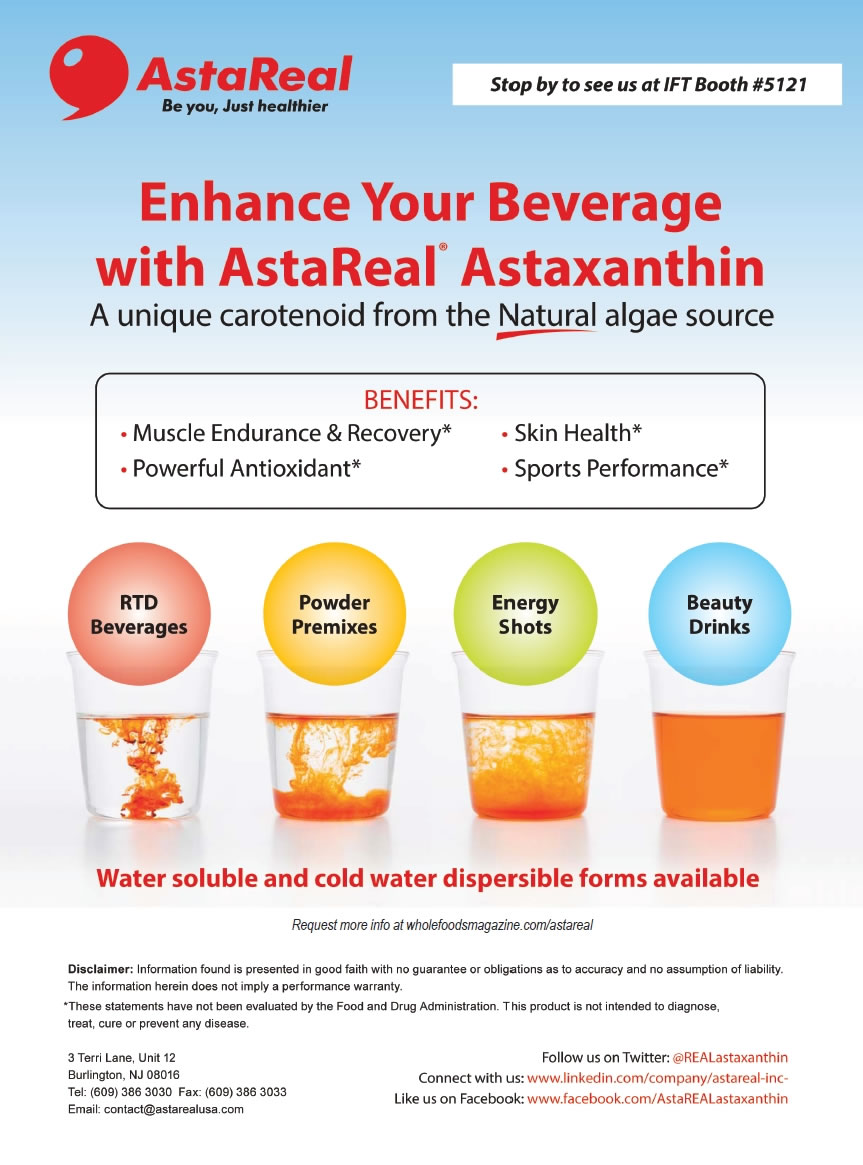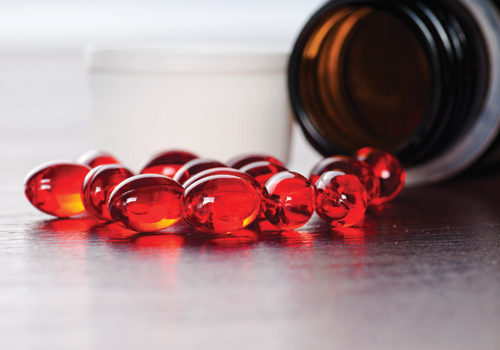The incredible feat of salmon swimming upstream to spawn is a wonder of nature. How do these fish get the energy to battle their way against the rapids? Some say it’s all due to their diet, which is rich in astaxanthin.
This red microalgae, which turns a salmon’s flesh pink, has numerous research-backed health benefits including energy support, immune health, skin health and more.
What Is Astaxanthin?
Algae and phytoplankton are the most prevalent sources of natural astaxanthin, and the specific species that produces this “King of Carotenoids” is called Haematococcus pluvialis. Algae cells stressed from extreme temperatures or a lack of food, water or sunlight will accumulate astaxanthin in their cells as a survival mechanism. The benefits of astaxanthin to algae are so significant that algae can remain dormant for decades in unfavorable conditions and spring back into a healthy green state thanks to its astaxanthin content (1).
Sea animals that consume astaxanthin-rich algae often have reddish or pinkish flesh like salmon, lobster, shrimp, trout and others. Natural astaxanthin is not only hugely beneficial to these and other sea animals, but this powerful antioxidant also has proven to be greatly valuable to humans.
Inflammation Support
Astaxanthin is said to offer some incredible anti-inflammatory and antioxidant properties, which makes this carotenoid beneficial to many aspects of health. Before we look at how astaxanthin fights inflammation, it is important to understand what inflammation really is. Inflammation can be a healthy immune response to help fight infections and damage.
But, chronic inflammation can be problematic, leading to various problems from joint issues to bowel diseases. While astaxanthin cannot be said to cure, treat or prevent any disease, astaxanthin offers anti-inflammatory support in several trials. Multiple studies suggest that astaxanthin suppresses  inflammatory mediators like tumor necrosis factor alpha (TNF-a), nitric oxide (NO), prostaglandin E-2 (PGE-2), interleukin 1B (IL-1B), COX enzymes and others (1), and also helps heal athletic and work injuries along with reducing the risk of carpal tunnel syndrome and arthritis (1).
inflammatory mediators like tumor necrosis factor alpha (TNF-a), nitric oxide (NO), prostaglandin E-2 (PGE-2), interleukin 1B (IL-1B), COX enzymes and others (1), and also helps heal athletic and work injuries along with reducing the risk of carpal tunnel syndrome and arthritis (1).
Natural astaxanthin also was found in a 2006 study to reduce levels of c-reactive protein (CRP) in the blood. In the eight-week study, the 16 study participants experienced an average 20.7% reduction in CRP levels. This is just one of several studies linking this carotenoid with healthier CRP levels.
A 2013 article published in the American Journal of Advanced Food Science and Technology attributed astaxanthin’s “potent antioxidant and anti-inflammatory activity” to the structure of its cellular membrane. The group found the molecules’ design lets them interact with reactive oxygen species in aqueous environments and gives it proximity to cofactors like vitamin C. In addition, certain white blood cells in the body also tend to uptake astaxanthin. Thus, the authors believe that astaxanthin accumulation in certain cells and its incubation “protects against inflammation and degenerative factors upregulated by IL 1B” (2).
A 2011 article from Joseph Mercola, D.O., underscored the role of this antioxidant in inflammation support noting that astaxanthin may take longer to demonstrate effects than anti-inflammatory drugs like NSAIDS, but it won’t result in dangerous side effects. This incredible free radical scavenger (said to be 65 times more powerful than vitamin C) is supporting a healthy state, not treating disease (3).
Immune Balance
On a related note, astaxanthin’s healthy inflammation supporting properties may also work to support overall immune health.
Astaxanthin may support the immune system by decreasing the damage done to the DNA, stimulating lymphocyte proliferation, increasing the production of T-cell dependent antigen and antibody-producing B-cells, amplifying natural killer cell cytotoxic activity and more (4). One researcher from Washington State University holds a patent saying that “2 mg of natural astaxanthin per day for a period of four weeks is sufficient to reduce DNA damage by approximately 40%” (4). The same research group also uncovered some anti-tumor activity, though this supplement cannot be said to treat any disease.
In a study on a branded astaxanthin supplement ingredient (BioAstin from Cyanotech Corp.), 80% of 302 survey respondents agreed that taking this carotenoid “improved immunity and/or increased resistance to colds and flu” (4).
Promotes Healthy Eyes
Astaxanthin is said to help support eye health from several angles, including antioxidant support. The retina (i.e., the eye’s camera) is actually an extension of brain tissue (5). Unlike other carotenes, astaxanthin can cross the blood–brain barrier and help the eyes, brain as well as the central nervous system (4). Antioxidants are essential to fight free radicals from damaging the eyes, which is especially important since most eye tissue is composed of fat and is highly affected by oxidation. In addition, the retina uses a lot of energy, and thus produces a lot of waste or oxidants (5).
The eyes are also prone to oxidative damage due to environmental factors like pollution, stress, contaminants and so on, so antioxidant intake can be important to maintaining normal vision. Once astaxanthin crosses the blood–brain barrier and reaches the eyes, it acts as an antioxidant and can further protect the eyes by increasing the blood flow to the retina.
Researchers have found that astaxanthin reduces the negative effects of eye fatigue and strain (4). On one study of individuals with eye strain, a daily dose of astaxanthin (6 mg, AstaReal from Fuji Chemical Industries) for one month helped improve pupil restriction and visual acuity without glasses (6). Another study (also on AstaReal oil) had similar results, with those taking 6 mg of astaxanthin for a month improving eye fatigue and accommodation time (7).
In addition, a 2012 study looked at how a high concentration of carotenoids in the macula can prevent age-related macular degeneration (AMD). It was also studied whether nutritional supplements could improve visual function and acuity in those with AMD. The study involved 145 patients who were randomly assigned two different treatments: one group took a placebo and the other took a combination of lutein, zeaxanthin, astaxanthin and other nutrients. After 24 months, the patients who received the treatment showed significant improvement and stabilization in contrast sensitivity, visual acuity and visual function (8).
Skin Nourisher
The King of Carotenoids will not erase wrinkles, but it will support several aspects of skin health, including diminishing some signs of aging and reducing ultraviolet (UV) damage. Sunburn occurs from excess skin oxidation, but astaxanthin may help protect skin from the sun’s UV rays while improving properties like elasticity, moisture and appearance. One study found taking 4 mg per day (BioAstin) increased how long it took for the skin to redden from UV light exposure (5).
The skin benefits don’t end there. In an eight-week study published in 2012, 30 healthy women were asked to take an astaxanthin supplement (AstaReal). After the end of the eight weeks, the women’s skin showed significant improvements in elasticity, skin texture, skin wrinkles, age spot size, moisture and corneocyte condition (9). Another study by the same group found improvements in men’s skin, too. The researchers state, “It may suggest that astaxanthin derived from H. pluvialis can improve skin condition in all layers such as corneocyte layer, epidermis, basal layer and dermis by combining oral supplementation and topical treatment” (9).
A separate analysis of skin cells at various layers came to a similar conclusion: astaxanthin improves skin integrity among various layers, and thus its potential as an inside–outside supplement is far reaching (10).
Muscle Support
Whether your shoppers are serious athletes or regular joggers, astaxanthin can help achieve faster muscle recovery, improved strength and joint support.
The anti-inflammatory properties of astaxanthin have become a significant tool for athletes and workout junkies. The normal but uncomfortable process of inflammation can prevent individuals from fast muscle recovery, sometimes leaving them unable to keep to repeated training schedule. But, this carotenoid may limit inflammation and pain after exercise (5).
Moreover, astaxanthin has showed to help keep athletes in tip-top shape. Once again the two properties of astanxanthin, antioxidant and anti-inflammatory, work together to protect mitochondrial cells from free radicals, and instead encourage the production of energy, which enables athletes to work longer and harder (1). In one study, athletes taking 4 mg of astaxanthin (BioAstin) for three weeks had less soreness after weightlifting and better recovery (5). A number of other studies suggest this form of astaxanthin may also increase stamina and endurance, possibly by benefiting lactic acid levels (1). WF
References
1. B. Capelli and G.R. Cysewski, Astaxanthin—Natural Astaxanthin: King of the Carotenoids (Cyanotech, 2007).
2. L.L. Kimble, B.D. Mathison and B.O. Chew, “Astaxanthin Mediates Inflammation Biomarkers Associated with Arthritis in Human Chondrosarcoma Cells Induced with Interleukin-1B,” Amer. J. Adv. Food Sci. Technol. 2, 37–51 (2013).
3. J. Mercola, “The Silent Inflammation That Afflicts 3 Out of 4 Americans,” July 12, 2011, http://articles.mercola.com, accessed Apr. 10, 2015.
4. B. Capelli and G.R. Cysewski, The World’s Best Kept Health Secret (Cyanotech Corp., 2012).
5. W. Sears, Natural Astaxanthin: Hawaii’s Supertnutrient (William Sears, MD, 2015).
6. M. Kajita, et al., “The Effects of a Dietary Supplement Containing Astaxanthin on the Accommodation Function of the Eye in Middle-aged and Older People,” Translated from Medical Consultation & New Remedies, 46 (3), (2009).
7. K. Shiratori et al., “Effect of Astaxanthin on Accommodation and Asthenopia- Efficacy-Identification Study in Healthy Volunteers,” Translated from Journal of Clinical Therapeutics and Medicines, Vol. 21 No. 6 (June) 2005.
8. S. Piermarocchi et al., “Carotenoids in Age-related Maculopathy Italian Study (CARMIS): Two-Year Results Of A Randomized Study,” Eur. J. Ophthalmol. 22 (2), 216–225 (2012).
9. K. Tominaga, et al., “Cosmetic Benefits Of Astaxanthin On Humans Subjects,” Acta Biochim Pol. 59 (1), 43–47 (2012).
10. K. Tominaga, et al., “Cosmetic Effects of Astaxanthin for All Layers of Skin,” Translated from Food Style 21, Vol.13 No.10 (October) 2009.
Published in WholeFoods Magazine, July 2015









